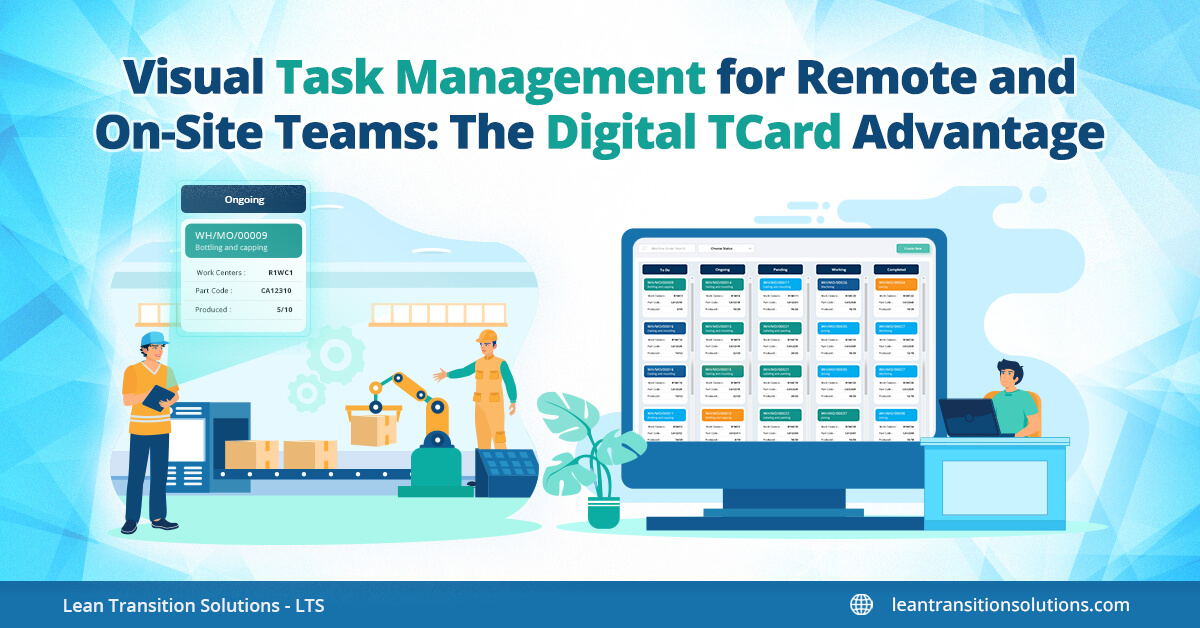Visual Task Management for Remote and On-Site Teams: The Digital T Card Advantage
February 18, 2025
With startups and corporate giants waving the green flag to hybrid work culture, teams end up in a cyclical switch of remote and on-site work routines. The chances are high that the omelette gets sideburned, and the other team doesn’t get a whiff of it. Are you a project manager trying to tie up the loose ends with delayed project updates, missed deadlines, and a lack of collaboration between the remote and on-site teams? Shuttling from one tab to another, chat box to another, pending emails, and notifications workflow management can be a bitter mess with no sweet returns. What if we said you could magically dash through visual boards designed to communicate: what’s happening, who’s doing what, and where the project has reached in a split second through a centralised dashboard? Read on to know about the digital tools we have designed and developed specifically for visual task management for remote and on-site teams. Get to know why you should add TCards among your hybrid work tools with us!
Track your Project Wherever You Go!
It’s a universal truth that visual understanding is baked into our own DNA. Being able to actually see the minute details that make up your project—from resource allocation to work breakdowns, task tracking, and project progress—can save you from dreaded downtimes, wrong prioritisation, and unidentified risks. Such a data-centric platform designed to give you deep insights must be ingrained with features like real-time tracking, collaborative feeds, customisable workflows, seamless integration with ERP, dynamic report generation, and much more. Check out how our visual task management tool, TCard, helps you carry your overloaded plate with technical grace, creative balance, and reporting ease.
Why is Visual Task Management for Remote and On-site Teams Important?
Visual project management is crucial for remote and on-site teams because it provides a clear, intuitive way to organise, prioritise, and track tasks, ensuring everyone stays aligned and focused. By using project visibility tools like TCards, Gantt charts, Kanban Boards or digital dashboards, teams can easily identify task progress, deadlines, and bottlenecks, fostering transparency and collaboration. This approach bridges the communication gap between remote and on-site members, enhancing accountability and productivity while reducing miscommunication. Ultimately, digital task management software for hybrid teams simplifies complex workflows and supports agile decision-making, which is essential for efficient teamwork in hybrid environments. Are you on the lookout for the best task management software for hybrid teams in the UK?
Comparison Chart: With and Without Visual Task Management Tools
Visual task management tools for remote and on-site teams can skillfully display that your project is a “bowl of salad” with lots of chopping through the project brief to be done, tossing around deadlines, some missing ingredients (technical and non-technical), and lots of prepping before product delivery. We know that when there’s too much to be done, visibility can go into hiding. But with us around, mapping the value stream and tracking everything that contributes value is not an uphill task (remember, we are the lean guys!). Wondering how to improve remote team collaboration with visual tools? Read along.
TCard Features Table
| Aspect | With Visual Task Management Tools | Without Visual Task Management Tools |
|---|---|---|
| Task Allocation | Tasks are visually assigned with clear owners and deadlines using a shared dashboard. E.g., a remote marketing team knows exactly who is writing content. | Unclear task ownership leads to confusion. E.g., both on-site and remote workers assume someone else is responsible for writing the content. |
| Progress Tracking | A Kanban board shows task statuses (e.g., "To Do," "In Progress," "Completed") at a glance. E.g., a product launch checklist is visible to all team members. | Team members frequently ask for updates via email or chat, leading to delays and misaligned priorities. |
| Team Collaboration | Real-time updates allow both remote and on-site teams to comment and suggest changes. E.g., a developer flags an issue on a TCard, and QA addresses it promptly. | Lack of centralised communication results in missed issues. E.g., a bug isn’t reported in time, delaying the entire project. |
| Meeting Efficiency | Visual dashboards minimise the need for long meetings. E.g., the team reviews the board during a 15-minute stand-up to align priorities. | Repeated meetings are needed to clarify progress, consuming valuable time. E.g., a one-hour meeting is spent reassigning missed tasks. |
| Deadlines | Automated reminders and progress indicators ensure deadlines are met. E.g., a remote designer receives alerts about an approaching submission date. | Missed deadlines due to poor tracking lead to rushed work. E.g., a designer submits incomplete assets after the deadline passes unnoticed. |
| Adaptability | Changing priorities are updated instantly on the board. E.g., a high-priority customer request shifts to the top of the list and everyone is notified. | Teams struggle to adapt to new priorities. E.g., a customer request is delayed because remote workers weren’t informed in time. |
| Accountability | Clear visibility of assigned tasks ensures accountability. E.g., each team member knows their role in a product sprint. | Lack of transparency allows tasks to fall through the cracks. E.g., no one takes ownership of a failed sprint goal. |
| Error Identification | Bottlenecks are visually evident. E.g., a build task stuck in "In Progress" for too long signals a technical issue needing immediate attention. | Errors go unnoticed until they cause major disruptions. E.g., a bug in development is discovered only during testing, delaying the release. |
| Team Morale | Transparent systems reduce stress, as team members clearly understand expectations. | Frustration builds due to misunderstandings, leading to poor team morale. |
What are the Key Features of a Visual Task Management Tool that Can Streamline Workflows and Improve Collaboration?
How to manage remote and on-site teams with visual task boards? Visual task management for remote and on-site teams is essential for streamlining workflows, improving collaboration, and ensuring clarity across hybrid work environments. Key features include:
- Task Visualisation: The ability to represent tasks visually helps teams track progress at a glance. TCards provide a user-friendly digital card-based system, allowing tasks to be displayed visually in columns representing their status (e.g., To Do, In Progress, Done). Real-time task tracking for hybrid teams is effortless with TCards!
- Real-Time Updates: Timely updates ensure all team members are aligned, regardless of location. TCards enable real-time task changes and status updates, making it easy for remote and on-site members to stay informed simultaneously.
- Customisable Workflows: Teams can adapt the task management system to their specific needs. TCards allow users to customise boards, fields, and card templates, catering to unique project or team requirements.
- Team Collaboration: Effective communication and shared understanding are critical. TCards facilitate seamless collaboration through features like task assignment, comments, and shared dashboards, ensuring every team member is connected and accountable.
- Performance Tracking and Reporting: Analysing team performance and project timelines helps optimise efficiency. TCards include built-in analytics and reporting tools, providing insights into task completion rates, bottlenecks, and overall team performance.
What are the Benefits of Digital Task Boards for On-site and Remote Teams?
Digital TCards are the best productivity tools for remote teams which offer several advantages for visual task management, making them ideal for supporting remote and on-site teams:
- Real-Time Collaboration: Digital TCards enable team members to update, assign, and track tasks in real time, ensuring that both remote and on-site workers stay synchronised and informed.
- Accessibility: Being cloud-based, Digital TCards can be accessed from anywhere, using any device, providing flexibility and ensuring that remote teams can stay connected with on-site counterparts.
- Enhanced Visualisation: Digital TCards provide clear, customisable layouts to visually organise tasks by status, priority, or team responsibility, improving task clarity and workflow management.
- Customisation: They offer the ability to adapt boards, workflows, and card templates to suit specific project or team needs, providing a tailored task management experience.
- Real-Time Notifications: Automated notifications and reminders keep teams informed about task updates, deadlines, or status changes, reducing communication delays.
- Integration with Other Tools: Digital TCards often integrate with project management, communication, and calendar tools, creating a seamless workflow for hybrid teams.
- Data Insights and Reporting: Built-in analytics provide insights into task progress, team performance, and bottlenecks, helping managers make data-driven decisions.
- Cost-Effectiveness: By reducing the need for physical boards, stationery, and in-person meetings, Digital TCards offer a cost-efficient solution for task management.
- Scalability: They easily adapt to the changing needs of growing teams or complex projects, ensuring consistent task management for businesses of all sizes.
- Eco-Friendly: Eliminating the use of paper and other physical resources, Digital TCards support sustainability initiatives while maintaining efficiency.
Streamline Your Workflow Today with the Digital T Card Advantage!
In today’s fast-paced hybrid work environment, staying organised and aligned is more critical than ever. Visual task management tools like Digital T Cards revolutionise how remote and on-site teams collaborate, offering real-time updates, customisable workflows, and powerful analytics to ensure every task stays on track. Say goodbye to missed deadlines, communication gaps, and inefficiencies—Digital T Cards bring clarity and productivity to your projects. Whether you’re managing a small team or a large enterprise, this intuitive solution empowers you to focus on what matters most: delivering results. Don’t let disorganisation hold your team back—embrace the Digital TCard advantage now!
FAQs
1. What is a Digital TCard?
A Digital TCard is an online tool that allows teams to manage tasks and workflows visually, offering a simple, intuitive way to track assignments and deadlines, whether for remote or on-site teams.
2. How does the Digital TCard improve task management for remote teams?
For remote teams, the Digital TCard offers real-time updates, easy task assignment, and clear visual representations of work progress, improving communication and accountability.
3. Can on-site teams benefit from using a Digital TCard?
Yes, on-site teams can benefit from a Digital T Card by streamlining task management, ensuring that everyone is on the same page and reducing the likelihood of missed deadlines or miscommunications.
4. How does Visual Task Management work in the Digital TCard system?
Visual Task Management in a Digital TCard uses boards and cards to represent tasks and their statuses, allowing team members to quickly see task progress, upcoming deadlines, and any potential bottlenecks.
5. Is the Digital TCard software easy to integrate into existing workflows?
Yes, the Digital TCard is designed to integrate easily with most project management systems, making it simple for teams to adopt without disrupting their current workflows.
A Digital TCard is an online tool that allows teams to manage tasks and workflows visually, offering a simple, intuitive way to track assignments and deadlines, whether for remote or on-site teams.
2. How does the Digital TCard improve task management for remote teams?
For remote teams, the Digital TCard offers real-time updates, easy task assignment, and clear visual representations of work progress, improving communication and accountability.
3. Can on-site teams benefit from using a Digital TCard?
Yes, on-site teams can benefit from a Digital T Card by streamlining task management, ensuring that everyone is on the same page and reducing the likelihood of missed deadlines or miscommunications.
4. How does Visual Task Management work in the Digital TCard system?
Visual Task Management in a Digital TCard uses boards and cards to represent tasks and their statuses, allowing team members to quickly see task progress, upcoming deadlines, and any potential bottlenecks.
5. Is the Digital TCard software easy to integrate into existing workflows?
Yes, the Digital TCard is designed to integrate easily with most project management systems, making it simple for teams to adopt without disrupting their current workflows.
